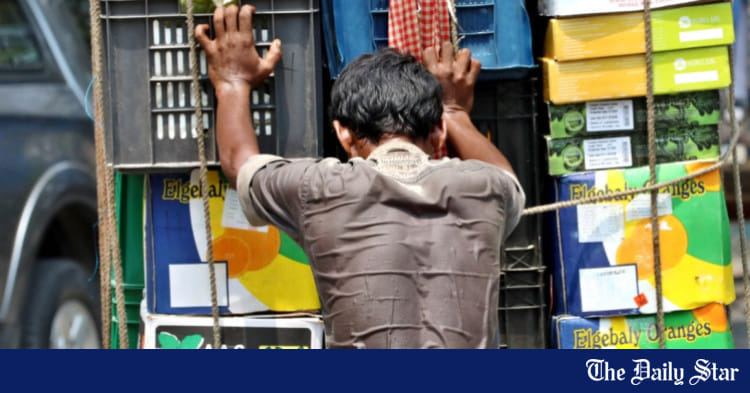Saif
Senior Member
- Joined
- Jan 24, 2024
- Messages
- 15,574
- Reaction score
- 7,889
- Nation

- Axis Group


Progress in recovering forest land, but pollution, polythene use not halted
Although action plans have been drawn up to tackle river and air pollution, comprehensive control over environmental degradation remains a challenge. The caretaker government, in its first year, however, has achieved some success in recovering forest land. Since 5 August last year, the Ministry...
Progress in recovering forest land, but pollution, polythene use not halted
Mostafa YusufDhaka
Published: 19 Aug 2025, 22: 14

Environment and rights activists, as well children participate in a sit-in programme organised by Janovassyo and earki in front of the Parliament Complex in Dhaka on 13 December 2024, demanding the formulation of an action plan immediately to prevent air pollution in the capital. File photo
Although action plans have been drawn up to tackle river and air pollution, comprehensive control over environmental degradation remains a challenge.
The caretaker government, in its one year, however, has achieved some success in recovering forest land. Since 5 August last year, the Ministry of Environment, Forests and Climate Change has cancelled allocations made for development projects and brought nearly 10,000 acres of forest land back under state protection.
During the same period, attempts were made to curb the use of polythene, though these efforts have so far failed—drawing criticism.
In Cox’s Bazar, recovery of forestland has offered some respite, but according to the Forest Department’s records, 19 elephants, an already critically endangered species, have died over the past year.
A dedicated elephant conservation project has now been launched. The ministry also pledged to free at least one river from encroachment and pollution, a promise that is yet to be fulfilled.
Meanwhile, confusion over the number of rivers in the country has at least been resolved. The National River Protection Commission and the Water Development Board have now produced a joint, standardised list, recording a total of 1,294 rivers across the country.
In efforts to curb noise pollution, the Department of Environment designated Shahjalal International Airport and the Secretariat area as “silent zones”. Despite running awareness campaigns, noise levels in these zones remain unchecked.

For burning garbage on the side of the road, the air has gone hazy with heavy smoke. This is polluting the environment on one hand while increasing health risks on the other. Photo taken from Imamganj Beribadh area in Dhaka on 17 May. Dipu Malakar
Speaking to Prothom Alo, Environment Adviser Syeda Rizwana Hasan observed, “The level of pollution inflicted on Dhaka’s rivers over the years cannot possibly be reversed in a year or two. Nevertheless, we have finalised plans to free four rivers in Dhaka, and 16 outside the capital, from both pollution and encroachment. We have identified the main sources of pollution and compiled a list of those responsible.”
Speaking on noise pollution, she added, “Under the new noise-control regulations being drafted, traffic sergeants will be empowered to fine drivers for honking the horns of their vehicles. At present, the law does not permit them to impose such penalties. However, without changing the deeply entrenched culture of excessive horn use, legal measures alone will not do.”
Cancellation of land allocations
During the previous Awami League administration, “mega development projects” exerted heavy pressure on forest land in Cox’s Bazar.
Twenty acres of reserved forest in Ramu were allotted to the Bangladesh Football Federation for a football academy, 700 acres in Shuknachhari were allocated to the Public Administration Ministry for a civil service academy, and 9,467 acres in Sonadia were set aside for the Bangladesh Economic Zones Authority (BEZA).
In addition, in 2017, 155 acres were allocated in the name of the brother of former cabinet secretary Shafiul Alam. Over the past year, these allocations have been cancelled and the land brought back under the control of the Forest Department.
The caretaker government has also scrapped a proposal by former environment minister Shahab Uddin to build a safari park at Lathitila reserved forest in Sylhet at a cost of Tk 1,000 crore (Tk 10 billion).

Air pollution File photo
According to Forest Department data, between August 2024 and June 2025 some 5,100 acres of forest land were recovered from encroachers. The planting of invasive species, Akashmoni and eucalyptus, has been banned. Beel Joanna and Beel Bhela in Rajshahi have been declared wetland sanctuaries.
Across 24 districts, a total of 138,613 acres of forest land remain under illegal occupation by 88,212 encroachers. In Gazipur, Chattogram and Cox’s Bazar, powerful land-grabbers are yet to be removed. Since 5 August last year, around 100 acres in Gazipur have been newly encroached; roughly 70 acres have been recovered.
Speaking about the overall situation, Chief Conservator of Forests Md Amir Hossain Chowdhury told Prothom Alo, “We have categorised forest encroachments into four types. Those are: industrial, resort, agricultural and market encroachments. In Gazipur, recovering forest land from industrial facilities is particularly difficult, as many have prepared forged documents and filed cases based on those. Until those cases are disposed of, eviction cannot proceed. We are, however, regularly removing the other three categories.”
Abu Morshed Chowdhury, president of the Cox’s Bazar Civil Society, said that in the past year no public body or influential person has been able to secure new forest allocations in the district; on the contrary, several institutional and individual allocations have been cancelled.
He further said that encroachment on the Bakkhali River has also been halted. Although hill cutting has decreased, it still occurs clandestinely. However, the offenders are being prosecuted.
In Tangail’s Madhupur, the Environment and Forest Ministry has launched efforts to restore the natural Shal forest.

Chimneys spew out black fumes from the brick kilns, polluting the air. The picture was taken from Mollar Hat area of South Keraniganj File photo
Speaking about this, Abu Naser Md Mohsin, divisional forest officer for Tangail, told Prothom Alo, “We have prepared a master plan for restoring the Shal forest. As a first step, 750 acres have been planted with Shal and associated native tree species such as Haritaki, Bahera, Halud and Chapalish. A further 1,100 acres of Shal forest will follow.”
Steps to conserve biodiversity on Saint Martin’s Island
The authorities have restricted tourist inflows and approved a Tk 70 million (7 crore) programme to create alternative livelihoods for residents dependent on tourism to protect biodiversity on Saint Martin’s Island.
Under the interim government's decisions, tourists may visit the island in November but must return the same day. In December and January, visits and overnight stays are permitted, subject to a daily cap of 2,000 tourists. From February, tourist access will be suspended.
Polythene and air-pollution remain challenges
In October 2024, the Environment Ministry issued a gazette notification banning polythene at malls and superstores. While compliance has been achieved in superstores, kitchen markets continue to use polythene, largely because affordable alternatives remain scarce. Some 50 tonnes of polythene have been seized in enforcement drives over the past two months.
At Karwan Bazar in Dhaka, most shoppers are still seen carrying vegetables, fish and other essentials in polythene bags.
Asked why he was using polythene despite the ban, private-sector employee Salam Miyazi told Prothom Alo, “People will keep using polythene until substitutes are readily available. The ban will work only if alternatives are on offer at a reasonable price.”
Speaking about this, Adviser Syeda Rizwana Hasan said, “We managed to stop polythene in superstores because persuading the operators there was relatively easier. Kitchen markets are different; we could not yet impose effective controls at the point of production. Besides, habits also matter. To end polythene use we must act on three fronts simultaneously - production controls, market monitoring and public awareness. That is exactly what we are trying to do.”
To curb industrial pollution, the government moved to install CCTV monitoring to verify whether effluent treatment plants (ETPs) are actually operated.
However, an official at the Department of Environment, speaking on condition of anonymity, said that while most factories have installed cameras, oversight remains inconsistent.
There has been no improvement in overall air quality over the past year. Although enforcement against polluting brick kilns has intensified, open waste burning, emissions from unfit vehicles and transboundary haze continue unabated.
The Department of Environment reports that 830 brick kilns were demolished over the year.
Savar has been designated as the country’s first “degraded airshed”, with a phased plan to shut down major sources of pollution there.
Professor Ahmad Kamruzzaman Majumder, dean of science at Stamford University and founder of the Centre for Atmospheric Pollution Studies (CAPS), told Prothom Alo, “Effective action has been taken against non-compliant brick kilns, and there has been progress on forest restoration. But the circular on vehicular emissions has not been enforced in practice. That is a failure of the government.”
“Stronger measures should also have been taken to curb river pollution,” he observed.
Mostafa YusufDhaka
Published: 19 Aug 2025, 22: 14
Environment and rights activists, as well children participate in a sit-in programme organised by Janovassyo and earki in front of the Parliament Complex in Dhaka on 13 December 2024, demanding the formulation of an action plan immediately to prevent air pollution in the capital. File photo
Although action plans have been drawn up to tackle river and air pollution, comprehensive control over environmental degradation remains a challenge.
The caretaker government, in its one year, however, has achieved some success in recovering forest land. Since 5 August last year, the Ministry of Environment, Forests and Climate Change has cancelled allocations made for development projects and brought nearly 10,000 acres of forest land back under state protection.
During the same period, attempts were made to curb the use of polythene, though these efforts have so far failed—drawing criticism.
In Cox’s Bazar, recovery of forestland has offered some respite, but according to the Forest Department’s records, 19 elephants, an already critically endangered species, have died over the past year.
A dedicated elephant conservation project has now been launched. The ministry also pledged to free at least one river from encroachment and pollution, a promise that is yet to be fulfilled.
Meanwhile, confusion over the number of rivers in the country has at least been resolved. The National River Protection Commission and the Water Development Board have now produced a joint, standardised list, recording a total of 1,294 rivers across the country.
In efforts to curb noise pollution, the Department of Environment designated Shahjalal International Airport and the Secretariat area as “silent zones”. Despite running awareness campaigns, noise levels in these zones remain unchecked.
For burning garbage on the side of the road, the air has gone hazy with heavy smoke. This is polluting the environment on one hand while increasing health risks on the other. Photo taken from Imamganj Beribadh area in Dhaka on 17 May. Dipu Malakar
Speaking to Prothom Alo, Environment Adviser Syeda Rizwana Hasan observed, “The level of pollution inflicted on Dhaka’s rivers over the years cannot possibly be reversed in a year or two. Nevertheless, we have finalised plans to free four rivers in Dhaka, and 16 outside the capital, from both pollution and encroachment. We have identified the main sources of pollution and compiled a list of those responsible.”
Speaking on noise pollution, she added, “Under the new noise-control regulations being drafted, traffic sergeants will be empowered to fine drivers for honking the horns of their vehicles. At present, the law does not permit them to impose such penalties. However, without changing the deeply entrenched culture of excessive horn use, legal measures alone will not do.”
Cancellation of land allocations
During the previous Awami League administration, “mega development projects” exerted heavy pressure on forest land in Cox’s Bazar.
Twenty acres of reserved forest in Ramu were allotted to the Bangladesh Football Federation for a football academy, 700 acres in Shuknachhari were allocated to the Public Administration Ministry for a civil service academy, and 9,467 acres in Sonadia were set aside for the Bangladesh Economic Zones Authority (BEZA).
In addition, in 2017, 155 acres were allocated in the name of the brother of former cabinet secretary Shafiul Alam. Over the past year, these allocations have been cancelled and the land brought back under the control of the Forest Department.
The caretaker government has also scrapped a proposal by former environment minister Shahab Uddin to build a safari park at Lathitila reserved forest in Sylhet at a cost of Tk 1,000 crore (Tk 10 billion).
Air pollution File photo
According to Forest Department data, between August 2024 and June 2025 some 5,100 acres of forest land were recovered from encroachers. The planting of invasive species, Akashmoni and eucalyptus, has been banned. Beel Joanna and Beel Bhela in Rajshahi have been declared wetland sanctuaries.
Across 24 districts, a total of 138,613 acres of forest land remain under illegal occupation by 88,212 encroachers. In Gazipur, Chattogram and Cox’s Bazar, powerful land-grabbers are yet to be removed. Since 5 August last year, around 100 acres in Gazipur have been newly encroached; roughly 70 acres have been recovered.
Speaking about the overall situation, Chief Conservator of Forests Md Amir Hossain Chowdhury told Prothom Alo, “We have categorised forest encroachments into four types. Those are: industrial, resort, agricultural and market encroachments. In Gazipur, recovering forest land from industrial facilities is particularly difficult, as many have prepared forged documents and filed cases based on those. Until those cases are disposed of, eviction cannot proceed. We are, however, regularly removing the other three categories.”
Abu Morshed Chowdhury, president of the Cox’s Bazar Civil Society, said that in the past year no public body or influential person has been able to secure new forest allocations in the district; on the contrary, several institutional and individual allocations have been cancelled.
He further said that encroachment on the Bakkhali River has also been halted. Although hill cutting has decreased, it still occurs clandestinely. However, the offenders are being prosecuted.
In Tangail’s Madhupur, the Environment and Forest Ministry has launched efforts to restore the natural Shal forest.
Chimneys spew out black fumes from the brick kilns, polluting the air. The picture was taken from Mollar Hat area of South Keraniganj File photo
Speaking about this, Abu Naser Md Mohsin, divisional forest officer for Tangail, told Prothom Alo, “We have prepared a master plan for restoring the Shal forest. As a first step, 750 acres have been planted with Shal and associated native tree species such as Haritaki, Bahera, Halud and Chapalish. A further 1,100 acres of Shal forest will follow.”
Steps to conserve biodiversity on Saint Martin’s Island
The authorities have restricted tourist inflows and approved a Tk 70 million (7 crore) programme to create alternative livelihoods for residents dependent on tourism to protect biodiversity on Saint Martin’s Island.
Under the interim government's decisions, tourists may visit the island in November but must return the same day. In December and January, visits and overnight stays are permitted, subject to a daily cap of 2,000 tourists. From February, tourist access will be suspended.
Polythene and air-pollution remain challenges
In October 2024, the Environment Ministry issued a gazette notification banning polythene at malls and superstores. While compliance has been achieved in superstores, kitchen markets continue to use polythene, largely because affordable alternatives remain scarce. Some 50 tonnes of polythene have been seized in enforcement drives over the past two months.
At Karwan Bazar in Dhaka, most shoppers are still seen carrying vegetables, fish and other essentials in polythene bags.
Asked why he was using polythene despite the ban, private-sector employee Salam Miyazi told Prothom Alo, “People will keep using polythene until substitutes are readily available. The ban will work only if alternatives are on offer at a reasonable price.”
Speaking about this, Adviser Syeda Rizwana Hasan said, “We managed to stop polythene in superstores because persuading the operators there was relatively easier. Kitchen markets are different; we could not yet impose effective controls at the point of production. Besides, habits also matter. To end polythene use we must act on three fronts simultaneously - production controls, market monitoring and public awareness. That is exactly what we are trying to do.”
To curb industrial pollution, the government moved to install CCTV monitoring to verify whether effluent treatment plants (ETPs) are actually operated.
However, an official at the Department of Environment, speaking on condition of anonymity, said that while most factories have installed cameras, oversight remains inconsistent.
There has been no improvement in overall air quality over the past year. Although enforcement against polluting brick kilns has intensified, open waste burning, emissions from unfit vehicles and transboundary haze continue unabated.
The Department of Environment reports that 830 brick kilns were demolished over the year.
Savar has been designated as the country’s first “degraded airshed”, with a phased plan to shut down major sources of pollution there.
Professor Ahmad Kamruzzaman Majumder, dean of science at Stamford University and founder of the Centre for Atmospheric Pollution Studies (CAPS), told Prothom Alo, “Effective action has been taken against non-compliant brick kilns, and there has been progress on forest restoration. But the circular on vehicular emissions has not been enforced in practice. That is a failure of the government.”
“Stronger measures should also have been taken to curb river pollution,” he observed.






































